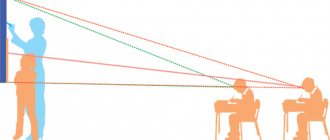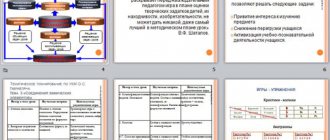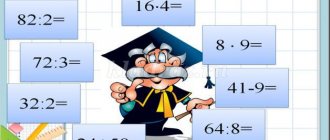Implementation of the activity approach in mathematics lessons in primary school
A successful person today is a moral, educated, enterprising person who is able to make decisions independently, ready for cooperation and business communication.
The one who is successful in school will be successful in life. Therefore, today the primary school has the goal of forming in the student not only subject-specific, but also universal methods of action that will provide the opportunity to continue education in primary school; develop the ability to self-organize in order to solve educational problems; ensure personal development. Achieving this goal is possible through the use of a systematic activity approach in practice, which is a universal tool that provides the teacher with the tools for preparing and conducting lessons in accordance with modern educational goals.
The systemic activity approach is a type of education that ensures the inclusion of children in active, independent educational and cognitive activity to the maximum extent, in other words, the creative assimilation of knowledge. The idea of such an organization of learning is that the child does not simply assimilate ready-made knowledge, but discovers new knowledge in the process of his own activities. The student’s personality, his readiness for independent activities in collecting, processing, and analyzing information, his ability to make decisions and bring them to execution come to the fore. At the same time, the condition for successful studies is that the student has high educational motivation and cognitive interest [1].
In my report, I want to touch on the topic of implementing a systemic activity approach in mathematics lessons in primary school. The use of problem-based learning techniques, project-based methods and group forms of work helps to implement an activity-based approach to teaching primary schoolchildren and increasing motivation and interest in the subject.
Thus, in lessons of discovering new knowledge, the use of problem-based learning techniques is very effective.
At the stage of familiarization with new material, a problem is created that ensures internal acceptance of the goal to obtain the intended result. The choice of solving the problem is joint with the students. The variability of problem resolution and individual choice are used [2].
Let's look at specific examples.
When studying the topic “Order of actions. Brackets" students are asked to look at examples and explain why the expressions have different meanings:
14–5 + 8 = 17
14–5 + 8 = 1
By comparing examples and analyzing the results obtained, students find out that the result of expressions depends on how to perform actions in it and determine that today in the lesson they will have to explore the problem of the order of performing arithmetic operations in numerical expressions, because the correctness of calculations depends on this.
Studying these examples, the guys find out that there are not enough parentheses in the second expression. Schoolchildren derive the following rules: 1) in expressions without parentheses containing only + and -, actions are performed in the order they are written: from left to right; 2) if there are parentheses in the expression, the actions in the parentheses are executed first.
A problematic situation when introducing the topic “Division with a remainder” in 3rd grade can be created by giving children the opportunity to complete a practical task:
24: 8 =
36: 9 =
18: 3 =
28: 4 =
9: 2 =
In the process of completing this task, the children have difficulty with the last example: the number 9 is not divisible by two. Then you can offer to work in pairs and try to divide 9 candies between each other. It turned out that everyone got 4 candies and one more. Students conclude that you can divide 9 by 2, but you get a remainder. Next, children formulate the topic and objectives of the lesson.
One of the effective methods that implements a systematic activity approach is the project method. By participating in project activities, students independently set goals, plan and carry out tasks, evaluate the results and present a presentation of the project.
In the process of this activity, students’ interest in knowledge is activated, new information technologies are mastered, scientific thinking, communicative qualities of the individual, and a creative approach to their own activities are developed [3].
Younger schoolchildren enjoy fantasizing, experimenting, making small discoveries, and, therefore, have all the prerequisites for the development of a creative personality.
In elementary school, during mathematics lessons, children are offered small projects designed for 1–2 lessons.
Let's look at examples of introducing design and research activities into the educational activities of primary school students.
So, for example, in the first grade, after getting acquainted with the numbers of the first ten and the number 0, you can invite children to participate in the search for materials on the topics: “Amazing Numbers”, “The Life of Zero - Numbers and Numbers”, “Great Numbers”, “My Favorite Number - five!
In the process of working on their first projects, children learn that information can be collected from various sources: from paper, electronic media, and information can also be obtained from other people through direct communication.
The child works on the assigned task, collects and summarizes information on the topic of the task. Then the work, independently or with the help of adults, is designed in the form of a collage, a baby book, etc., and during the lesson itself the child presents and defends the project.
When getting acquainted with word problems, you can offer schoolchildren individual and group work during the lesson itself - to compose text problems based on the picture for the fairy tales “Kolobok”, “Turnip”, “The Wolf and the Seven Little Goats”. Children write down their texts on pieces of paper and attach them to whatman paper with illustrations.
While studying the section “Tabular multiplication and division”, working on the project “Unconventional ways of memorizing the multiplication tables” will be effective. During the project, students are given tasks: to find unusual ways to memorize the multiplication table, choose the most interesting ones for themselves, learn to apply them in practice, and teach their classmates to use new ways to memorize the multiplication table.
Thus, the project method organically complements and expands students’ learning activities in the classroom and contributes to the self-improvement of schoolchildren.
Great opportunities for organizing effective educational activities are also provided by the group form of work in the classroom. It solves three main problems: cognitive, which is associated with the immediate learning situation; communicative and developmental, during which basic communication skills are developed; socially oriented, cultivating civic qualities necessary for the successful socialization of students.
The simplest type of group work is pair work. Students sitting at the same desk work together. In this pair, students constantly change the roles of teacher and student. They can teach each other - mutual learning, they can control - mutual control. When reinforcing a new topic, for example, you can ask students to come up with assignments on the topic being assigned. You can organize such work both during the lesson itself and in advance. At home, students prepare cards for a neighbor, come up with or select exercises, and solve them. During the lesson, children exchange cards, act as teacher and student, simultaneously deciding and controlling each other.
Another option for group work is working in a microgroup, in a team. For example, at the beginning of the lesson, in order to repeat what has been previously learned, you can organize a mathematical relay race. The class is divided into teams (by rows and options), players take turns completing tasks. Each player passes tasks with solutions to the next student, who must not only complete his own, but also check previous completed tasks and correct mistakes, if any. The winner is the team that is the first to complete the tasks, solving them correctly.
Working in pairs and groups allows the child to feel protected, to perceive himself as a member of the team, there is an opportunity to correct mistakes before being checked by the teacher, thanks to mutual assistance and mutual verification.
Thus, the use of problem-based learning techniques, project-based methods and group forms of work gives the teacher the opportunity to implement an activity-based approach, and therefore contribute to the successful learning and socialization of younger schoolchildren. The leading characteristics of a primary school graduate are his ability to think independently, analyze, the ability to construct statements, put forward hypotheses, and defend the chosen point of view; the presence of ideas about one’s own knowledge and ignorance on the issue under discussion. Students master fundamentally new roles - not just “spectator”, “listener”, “reproducer”, but “researcher”. This position determines the interest of younger schoolchildren in the process of cognition.
Literature:
- Electronic educational resource. Fisenko T.I. System-activity approach to the implementation of new generation standards. URL: https://slovesnic.ru/index.php?option=com_content&view=article&id=329:2013–05–08–15–34–22&catid=49:2012–12–16–14–08–14&Itemid=67
- Melnikova E. L. Technology of problem-based learning // School 2100. educational program and ways of its implementation. Vol. 3. -M., Balass, 1999. - pp. 85–93
- Balakleets V.V. Using the project method in mathematics lessons when teaching primary schoolchildren // Young scientist. - 2017. - No. 4. - P. 357–359.
Activity-based approach to teaching mathematics
Activity-based approach to teaching mathematics
When people are taught something other than what they should think,
and how they should think, then all misunderstandings will disappear.
G. Lichtenberg
As you know, the current modernization of Russian education is based on the ideas of personality-oriented developmental education. The adoption of the new Federal State Educational Standard of NEO is the recognition of the system-activity approach in education as the basis for constructing the content, methods and forms of the educational process.
Federal State Educational Standard: paragraph 7 “The standard is based on a system of activity approach, which represents:
— education and development of personality traits that meet the requirements of the information society;
— transition to a strategy of social design and construction in the education system based on the development of educational content and technologies;
— orientation towards the results of education (development of the personality of students based on universal learning activities), which means the ability to learn, i.e. the student’s ability for self-development through the conscious and active appropriation of new social experience.”
The system-activity approach provides:
— formation of readiness for self-development and continuous education;
— design and construction of the social environment for the development of students in the education system;
— active educational and cognitive activity of students;
— construction of the educational process taking into account the individual age, psychological and physiological characteristics of students.
The system-activity approach assumes:
— a variety of organizational forms and taking into account the individual capabilities of each student (including gifted children and children with disabilities), ensuring the growth of creative potential and cognitive motives;
— guarantee of achieving the planned results of mastering the basic educational program of primary general education, which creates the basis for students’ independent successful acquisition of knowledge, skills, competencies, types, methods of activity.
This approach to teaching is aimed at the development of each student, at the formation of his individual abilities, and also allows him to significantly strengthen knowledge and increase the pace of learning the material without overloading students. At the same time, favorable conditions are created for their multi-level training. The technology of the activity-based teaching method does not destroy the “traditional” system of activity, but transforms it, preserving everything necessary for the implementation of new educational goals.
Each subject has its own characteristics in organizing the educational process on a systemic and activity basis.
The system-activity approach to teaching mathematics requires the formation of practical skills in applying theory. The position of a mathematics teacher should be this: to the class not with an answer, but with a question. Students should be able to identify, compare, generalize, evaluate with mathematical concepts, create mathematical models, i.e. master those universal methods that will be useful to them in practice.
The basic principles of constructing a school mathematics course based on a system-activity approach should be [5, 7]:
- the principle of systematic construction of a mathematics course;
- the principle of describing a mathematics course in the unity of the general, the particular and the individual;
- the principle of the optimal combination of fundamentality and professional orientation of teaching a mathematics course;
- the principle of subject activity when studying a mathematics course;
- principle of developmental education.
- Instead of simply transferring knowledge, skills and abilities from teacher to student, the priority goal of school education becomes the development of the student’s ability to independently set educational goals, design ways to implement them, monitor and evaluate their achievements, in other words, the ability to learn.
- Therefore, teachers need to master pedagogical technologies with which they can implement new requirements.
As an example, I will give a fragment of the lesson: “Vieta’s theorem.” Learning theory is one of the most difficult issues in teaching mathematics.
A lesson based on the principles of a systemic activity approach instills in students such skills that make it possible to use them in subsequent education and in later life. . When implementing the new standard, each teacher must go beyond the scope of his subject, thinking, first of all, about the development of the child’s personality, the need to develop universal educational skills, without which the student cannot be successful either at the next stages of education or in professional activities.
The systemic-activity approach in education is not a set of educational technologies, methods and techniques, it is a kind of philosophy of education of a new school, which allows the teacher to create, search, become a master of his craft in collaboration with students, work for high results, and develop in students universal learning activities - thus preparing them for continued education and for life in constantly changing conditions.
Teacher is the most difficult subject in the transition to the Federal State Educational Standard, as the authors of the project admit. It is high time for him, the teacher, to stop being a carrier of knowledge, its mechanical translator, distributor. It is necessary to pose a problem to the student so that he makes a discovery for himself, albeit small, but his own. This is truly a task of tasks.
Bibliography
1. Blauberg I.V., Yudin E.G. Formation and essence of the systems approach. – M.: Nauka, 1973. – 279 p.
2. Borovskikh A.V., Rozov N.Kh. Activity principles in pedagogy and pedagogical logic: A manual for the system of professional pedagogical education, training and advanced training of scientific and pedagogical personnel. – M.: MAKS Press, 2010. – 80 p.
3. Vorontsov A.B. The practice of developmental education according to the system of D.B. Elkonina–V.V. Davydova. – M.: TsPRU “Personality Development”, 1998. – 360 p.
4. Davydov V.V. Developmental learning theory. – M.: Intor, 1996. – 544 p.
5. Dalinger V.A. System-activity approach to teaching mathematics // Science and era: monograph / ed. O.I. Kirikova. – Voronezh: Publishing House VGPU, 2011. – P. 230–243.
6. Dalinger V.A. Competence-based approach and educational standards of general education // Educational and innovative technologies: theory and practice: monograph / ed. O.I. Kirikova. – Book 2. – Voronezh: VSPU Publishing House, 2009. – P. 7–18.
7. Malygina O.A. Teaching higher mathematics based on a system-activity approach: textbook. allowance. – M.: Publishing house LKI, 2008. – 256 p.
8. Federal state educational standard of general education. – M., 2008. – 21 p.
9. Yudin E.G. Systematic approach and operating principle. – M.: Nauka, 1978. – 342 p.
10.Internet resources:
www.vgf.ru https://www.festival.1septembr.ru
https://www.shkola.edu.ru https://www.pedsovet.org





